SHROUD OF TURIN
PICTURE TOUR WITH DR JOHN DESALVO
PAGE 3 of 5
In 1978 the Shroud was studied continuously for 5 days by a group of scientists from the United States known as the "Shroud of Turin Research Project" (STURP). They studies the Shroud using some of the most sophisticated scientific equipment available. Below to the left are STURP scientists placing a special applicator on the Shroud which would remove surface fibers on tape. These tapes could taken be taken back to the United States for further studies. To the right is Swiss criminologist, Max Frei removing samples using a tape dispenser. Our research team ASSIST obtained all of the 1978 Max Frei sticky tape samples from his widow in 1986. The sticky tape samples from the Shroud were used to analyze the blood areas and all the scientific tests concluded that the blood stains on the Shroud were indeed human blood. It was discovered that the blood went on the Shroud first and than the body image was produced.
SLIDE 15 - Scientists removing sticky tape samples from the Shroud
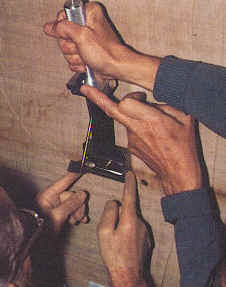
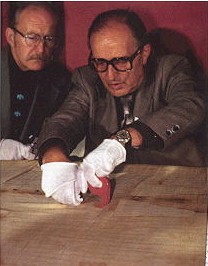
©1978
Barrie M. Schwortz Collection, STERA, Inc.
Area of the Shroud with the alleged blood stains
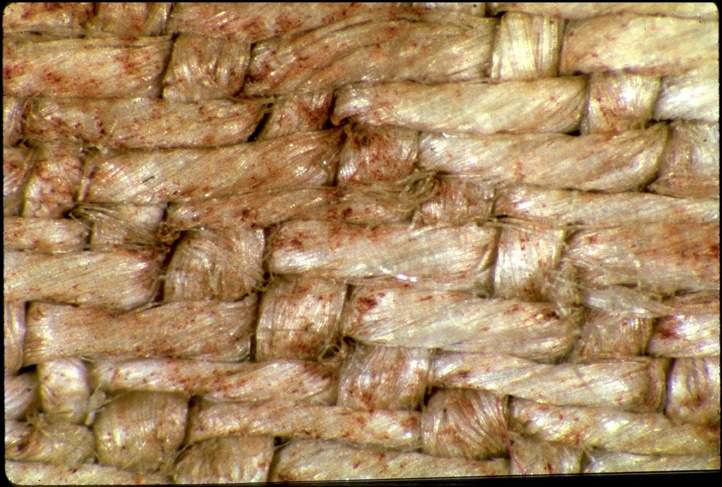
©1978
Barrie M. Schwortz Collection, STERA, Inc.
The special table in the Royal Palace to place the Shroud for the scientific testing

©1978
Barrie M. Schwortz Collection, STERA, Inc.
In 1976 it was discovered that the Shroud contained three dimensional information that only a computer could decode. When a photo of the Shroud was placed in a new type of computerized instrument known as a VP-8 image analyzer, the man in the Shroud could be seen in three-dimensional relief, just like a statue. This occurred because the intensity of the body image was directly related to the cloth to body distance. The nose being closer to the cloth would leave a more intense image. The cheeks being farther away would leave a less intense image. Thus the farther away a body feature is from the cloth the less intense its image would be on the cloth. Thus the VP-8 by measuring the image intensities on the cloth and assuming a certain drape of the cloth could reconstruct the man in 3D. This proved that the cloth wrapped a three-dimensional object, most likely a human being.
SLIDE 16 - 3-D Reconstruction of the image on the Shroud
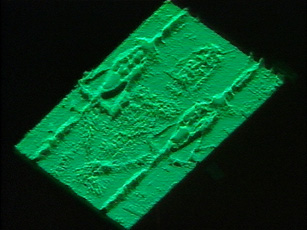
©1978
Barrie M. Schwortz Collection, STERA, Inc.

©1978
Barrie M. Schwortz Collection, STERA, Inc.
IMAGE FORMATION THEORIES
The Painting Theory
One theory is simply that the Shroud is a painting . It has been proposed that it was painted using iron oxide in an animal protein binder. The STURP scientists have concluded from their studies that no paints, pigments, dyes or stains have been found to make up the visible image. Small amounts of iron oxide have been found on the Shroud but the iron oxide is evenly distributed all over the Shroud. If it were painted using iron oxide you would expect its concentration to be greater in the image areas verses the non-image areas. This is not the case but the iron oxide is evenly distributed all over the Shroud. Thus it is probably a containment caused by the presence of the Shroud in artists studios throughout history who were copying it. It is also possible that the copies may have been touched to the Shroud to transfer its sacredness and this contaminated the Shroud with iron oxide.
Also no painter has been able to reproduce all the different qualities and characteristics of the Shroud. That is, its negativity, 3D effect, no brush strokes or directionality, perfect anatomical details from blood stains, scourging, etc. and the image is a surface phenomena, that is the image only penetrates about 1/500 of an inch into the cloth. It was shown that the blood went on first and than image. Try doing that and then painting the body image. Thus up to now no one has been able to reproduce the Shroud in all its characteristics. Most scientists reject the painting theory.
Recently there have been many who have claimed to reproduce the Shroud image. Some may have duplicated one or more of the characteristics but not all of them as mentioned above. All you have to do is put any of the artists production next to the shroud image and you will see there is no comparison. The shroud image is unique and no artist has been able to produce anything that comes near the shroud image.
The
Radiation Theory
Could the image have been produced by a burst of radiation (heat or light) acting over short period of time which would have scorched the cloth? Scientists have not been able to duplicate the characteristics of the Shroud using this method just like the painting hypothesis. Also the color and ultraviolet characteristics of the Shroud body image and a scorch are different. The shroud body image does not fluoresce under UV light but scorches like the burns from 1532 do fluoresce under UV light. Thus many scientists rule out the radiation theory.
Other
theories
There are other theories regarding vapors from the body diffusing to the Shroud and producing the image. Another theory is a direct contact process in which substances were directly transferred to the cloth and produced the image. My theory takes both of these into consideration.
DeSalvo's Revised
Vaporgraphic - Direct Contact Theory
Nature may have supplied us with a miniature example of how the Shroud body image was produced. It is known that when certain plant matter (such as leaves) are placed in a book and left undisturbed for many years, there develops on both the upper and lower sheets of paper a faint sepia colored imprint of the plant matter (called Volckringer patterns). Dr. Jean Volckringer in the 1940's noticed that these plant images closely resemble the body image on the Shroud of Turin. In fact the plant imprint also appears to be a negative image, just like the Shroud, and when photographed a positive imprint appears on the negative plate.
SLIDE 17 - Imprints
(Volckringer Patterns) that plant matter produce in
books
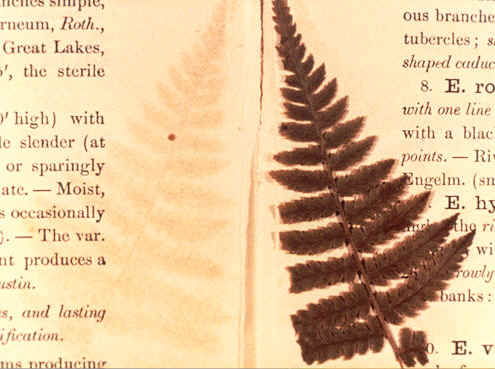
SLIDE 18
- Volckringer Patterns
exhibiting positive and negative characteristics
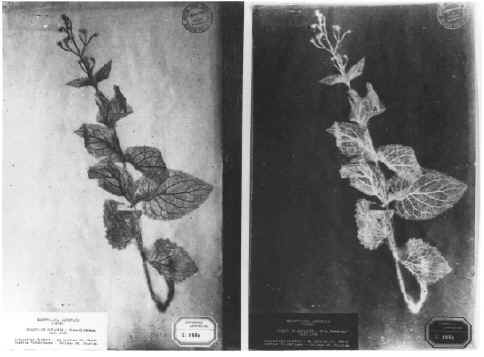
I decided to explore this similarity in more detail. I was hoping that by understanding how Volckringer Patterns are produced, it would give me some idea of how the Shroud body image was produced. Using a spectrophotometer I did a color comparison between the Volckringer patterns and the Shroud body image. Within experimental error, I showed that the Volckringer patterns were identical in color to the Shroud body image. I than compared the Shroud and Volckringer patterns using UV Fluorescent studies. It was shown that both the Volckringer patterns and the Shroud body image do not fluoresce under UV light. Thus the Volckringer patterns and Shroud body image also have identical UV fluorescent characteristics.
The most startling similarity was that the Volckringer patterns could be reconstructed in 3D relief using a VP-8 analyzer, just like the Shroud body image.
SLIDE 19
- 3-D Reconstruction of a Volckringer
pattern
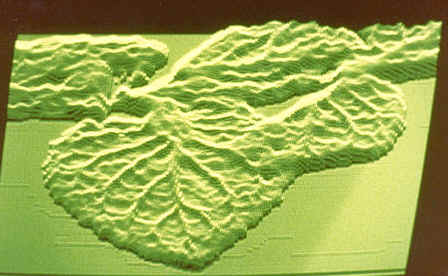
SLIDE 20
- Another angle of the 3-D
reconstruction
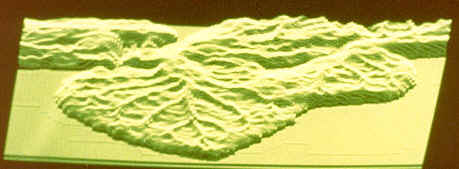
In summary, Volckringer patterns resemble the Shroud body image in negativity, visible color characteristics, UV fluorescence properties, and 3D reconstruction.
Volckringer patterns are produced when acids from the plant are transferred to the paper causing cellulose degradation (oxidation). The most prominent plant acid in this process is lactic acid. Where would lactic acid fit in with the Shroud body image formation process? Human perspiration contains a certain amount of lactic acid. A person who had been tortured and crucified would have sweated profusely and medical studies have shown that this perspiration would have very high concentrations of lactic acid. Thus, this could have been the transferring agent involved in producing the body image on the Shroud. The lactic acid would have been transferred to the cloth by both direct contact and vertical diffusion. Areas of the body like the nose that touched the cloth would transfer the lactic acid by direct contact. In the areas further away that did not touch the cloth, i.e. the cheeks, the lactic acid would travel to the cloth by diffusion. Thus two processes, both direct contact and vertical diffusion would transfer the lactic acid to the cloth. Than this acid would oxidize the cellulose in the linen and produce the image over a period of time. It may be that originally there was no image on the cloth and after many years the lactic acid working on the cloth eventually developed the image. This is what occurs with the plant matter in books. My theory does not answer all the questions. Some problems are that the Shroud body image is a surface phenomena but the Volckringer patterns are not. They penetrate into the paper. Also calculations using diffusion of lactic acid would not produce the high resolution of the image we see on the Shroud. Thus my theory does not explain all the characteristics of the Shroud and more research needs to be done. Thus no one theory to date can explain how the image on the Shroud was produced.
IT
IS STILL A MYSTERY